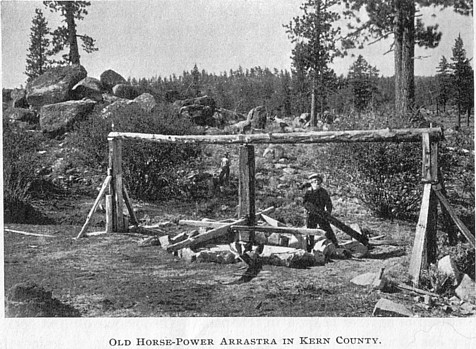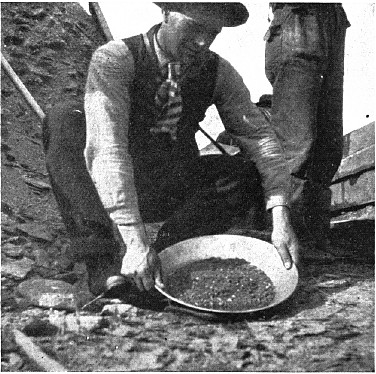Many men seem to think that should their destinies lead them into parts of the world where there is mineral wealth they will have little chance of discovering the deposits without the technical education of a mining engineer. This is wrong. The fact is that the sphere of the prospector does not cover that of the engineer. The work of the one ends where that of the other begins, and many of the most successful discoverers of metallic wealth have been entirely ignorant of the methods by which a great mine should be opened, developed, and worked. A few simple tools and a not very deep knowledge of assaying, with an observant eye and a brain quick to deduce inferences from what that eye has seen, are the most valuable assets of a prospector. In time he will gain experience, and experience will teach him much that he could not learn in any college nor from any book. Each mining district differs from every other, and it has been found that certain rules which hold good in one region, and guide the seeker after wealth to the hidden treasure that has been stored up for eons of time, do not apply in another region.
To show what may be done with imperfect, improvised apparatus, an Australian assayer, who has since become famous, started up country in his youth with the following meager outfit: A cheap pair of scales, a piece of cheese cloth, a tin ring 1-2 inches by 1-2 inch, a small brass door-knob, some powdered borax, some carbonate of soda and argol, a few pounds of lead lining taken from a tea chest, an empty jam pot, a short steel drill, a red flower pot. With this modest collection of implements he made forty assays of gold ores that turned out to be correct when repeated in a laboratory.
About the best advice that can be given to a man who has determined to go to some out of the way region where there is a possibility of his discovering minerals is to recommend him to visit the nearest museum and gain an acquaintance with the common rocks. Should he be unable to do this he had better provide himself with small, inexpensive specimens from the shop of some dealer. It is almost impossible to teach a beginner to distinguish the various rocks by any amount of printed instruction ; the only way to learn to recognize them is to handle them and note carefully their color, weight, and the minerals that go to make them up. The explorer should be able to recognize at a glance, or at any rate after a very short inspection, the sedimentary rocks, such as sandstone and limestone; the metamorphic rocks, that is, rocks that have been altered by the agency of great subterranean heat in ages long past, and which were probably stratified rocks at one period, such as granite and gneiss, and the truly igneous rocks trap, diabase, diorite, etc. He must know also that mysterious rock which the western miner calls porphyry, and to which is ascribed most wonderful virtues in the way of ore attraction ; while dolerite and dolomite must be to him familiar terms and substances. This sounds easy enough but the student will find that a good deal of hard work is necessary before he can readily recognize each of these rocks.
It is even more necessary that he should learn the metals thoroughly. Each one differs from all the rest in some particular. Often this difference will be an obscure one, but to the careful investigator the recognition of the substance will be in the end certain. They may differ in weight, in color, in hardness, in a dozen different ways, so that to the man who has made a study of this subject a determination is always possible. On account of the wonderful discoveries in the Canadian Northwest and in Alaska, the eyes of thousands are turned towards those fields. Wonderfully rich placer ground has already been found and there can be no reason to doubt that very much larger areas remain unproved. Where this gold comes from is an open question; geologists, mineralogists and chemists, not to mention mining engineers and practical prospectors, have disputed over the source of the gold already found, but it must be confessed that there are almost as many theories as there are disputants. Could it be known with certainty how and under what conditions the gold got where it is found, the problem of seeking for it might be made easier. Unfortunately this is not the case, and all prospecting for the home of the precious metal is more or less a groping in the dark. We do know that the heaviest particles of gold do not travel far from where they were first deposited, because gold is so enormously heavy its specific gravity being about nineteen times that of water it seeks the bottom of the stream and stays there. It is not an invariable rule that the gold increases in coarseness as the stream is ascended, but it is a very general one.
On some rivers rich and poor stretches of gold bearing gravel succeed one another as the explorer makes his way up or down stream. This is difficult to account for, but in many cases is believed to be caused by the modern river robbing the bed of some one or more ancient water-courses whose beds crossed the valley of the present stream. This may or may not be the case. We only know that the miners who found coarse gold on the lower regions of such streams as the Frazer River in British Columbia were miserably disappointed when they reached stretches near the source and found nothing but flour gold. This same feature has been noticed in some of the Alaskan rivers. It is quite within the bounds of probability that no very rich quartz veins exist in Alaska. It does not follow from the richness of the placers that the gold is derived from very rich quartz lodes, because this amount of gold may really represent the product of a vast amount of rock that has been ground to powder and washed away in the course of ages. The gold would not travel far, and the deposits being unearthed to-day have been accumulating in these northern streams since the world was young; water-courses are nature's ground sluices.
It is possible that one stream has cut through the drainage of another. Sometimes this has impoverished the first and enriched the second, while in other cases the reverse has obtained. Upheavals have formed faults and fractured the strata, and the gold may have been deposited by solution in these fractures. Often the soil will have been washed away from near the top of the mountain, so that layers of stratified rock are seen to be duplicated on each side while they are covered at the summit. The prospector keeps his eye open as he goes along and notes carefully the character of the fragments of rock he finds in the streams. Quartz, diorite, diabase, and porphyry pebbles are grounds for expecting a profitable result, but of course there is no certainty of such a happy issue. As soon as the district begins to be fairly well known certain discoveries are made that invariably render prospecting easier. Local peculiarities are noted and certain characteristics are found to be common to the ore-bearing bodies or deposits; the lines of deposits become known, and a good deal of light is then shed upon a very difficult problem. As a rule, when the fragments of quartz, pyrite, chalcopyrite, or galena are rough, they have not traveled far, and the lode from which they have been derived should be close at hand. Water and attrition soon round these minerals on their sharp edges, and thus shows that they have come from some little distance.
In some countries, especially where vegetation is scanty and the soil thin, the outcrop of a body of mineral may be traced by a difference in the vegetation. In South Africa a chain of pools usually follows the course of a line fault, which in its turn marks where an intrusive lode carrying mineral separates two different formations. As a rule, any heavy mineral is worth investigating. Even in remote regions silver, mercury, tin, nickel, platinum, copper, and several other metals are worth paying attention to. If they are too far away from the railroad or the steamboat to-day they may not be so next year,, for civilization advances with giant stride in these days and never faster than when transportation companies are reaching forth to some newly discovered mineral field.
.
Continue on to:
The Basics of
Hard Rock Prospecting, Part 2
Return To:
Gold and Silver Prospecting Basics


